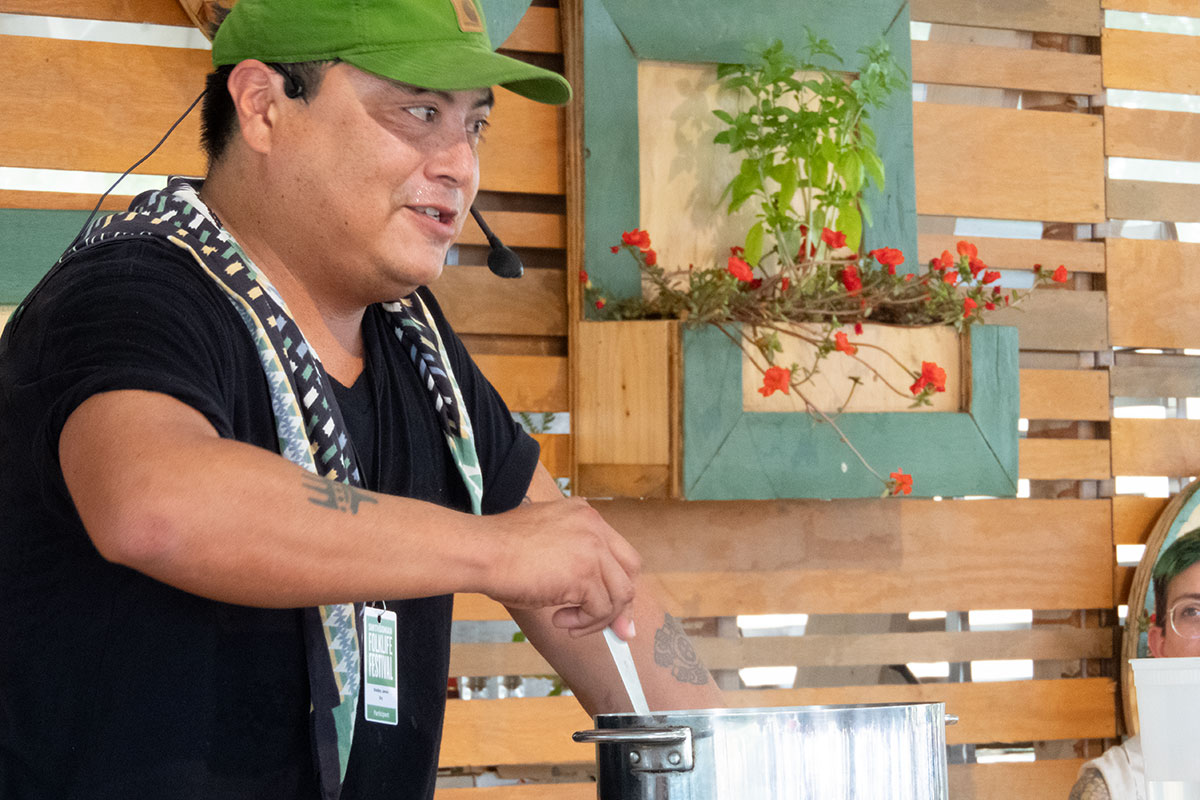With His Grandmother and Reservation Dogs, Chef Bradley Dry Preserves Cherokee Cuisine

Chef Bradley Dry cooks at the 2023 Smithsonian Folklife Festival.
Photo by Craig Fergus, Ralph Rinzler Folklife Archives
“Some of my favorite meals growing up were hog fries, fish fries, and beans and cornbread. We were always together as a family when we ate those dishes, and I cherish those memories deeply.”
A Cherokee food stylist and freelance chef, Bradley Dry will tell you that he owes his culinary career to his heritage—and especially his grandmother. She taught him many traditional recipes from the Appalachian region, stretching from the Catskills in New York down past the Great Smokies into Alabama and Mississippi.
While Dry does not describe his cooking as “Appalachian,” there is a rich culinary history that he brings to the table every time he prepares a meal. Appalachian cuisine is a combination of Scots-Irish, African American, and Indigenous cultures whose interaction dates back to colonial America. When the Cherokee Nation kept enslaved West Africans, those culinary traditions intermingled as well.
In the 1830s, the Indian Removal Act, signed by President Andrew Jackson, forced Indigenous communities in Appalachia off their land. This migration at gunpoint became known as the Trail of Tears. What had been the Cherokee Nation’s territory was carved up for white settlers. After this forced displacement, when thousands died from disease and freezing temperatures, Dry’s ancestors rebuilt their lives in Twin Oaks, a small, mostly Cherokee town in northeastern Oklahoma. Many generations later, his grandmother, Mildred Raper, was born.
Dry primarily grew up in Little Kansas, one town away from Mildred. As a child, he spent most of his afternoons and summers at her house, watching her cook, eager to lend a hand. Now, a professional chef, he lives in downtown Tulsa where he has worked in restaurants for over a decade. During the pandemic, he went freelance, eventually landing an opportunity to cater for the cast and crew of and create the prop food for Reservation Dogs, the TV series created by all Indigenous writers and directors—including Dry’s friend, filmmaker Sterlin Harjo.
Dry’s mission is to keep his grandmother’s Cherokee culinary knowledge alive through demonstrations like those he led at the 2023 Smithsonian Folklife Festival. But safeguarding the family recipes has proven difficult.
“Out of thirty grandchildren, I’m the only grandchild who still cooks with my grandmother’s style,” he laments. “I have a niece, and it’s rewarding to see how she is interested in cooking just like I was when I was her age.”


In the Festival Foodways tent, he cooked traditional kanuchi, a sweet soup made with rice and hickory or pecans. The sweet, warm smell of cinnamon lingered in the air as we talked following his demonstration. “I use ingredients that were brought over by the Europeans sparingly to keep dishes in their most traditional form,” Dry explained. (Get the full recipe for Dry’s kanuchi on the Ozarks program recipe page.)
While attending culinary school, he realized that he couldn’t learn cooking through memorization. Much more hands-on, he found the recipes he produced were almost intuitive. “The way I learned how to cook was through the matriarchs of my family. That knowledge was passed down from the beginning. I can’t read a book and learn. It just doesn’t make sense to me.” His method follows a historical precedent: few Native American tribes used written languages before colonization and instead preserved their cultures through oral tradition.
When he traveled to Norway to trade recipes with the Indigenous Sámi, on what he describes as a “culinary exchange program,” Dry was surprised to find overlaps. “Cooking opens the door for so many conversations,” he marveled. “Even if you don’t speak the same language as someone else, you can have similarities in the way you cook and can tell how your communities interacted in the past. That’s such a unique and special feeling.”
We headed toward the back of the demonstration kitchen, and he ladled me out a bowl of kanuchi. It was still warm and had the consistency of a thin porridge. While this was my first time trying the dish, I understood the homey feeling that came with it. The rice was cooked down enough to break apart in my mouth and fully absorb the subtly sweet liquid it rested in. The pecans were soft but still had a bite to them. Their nuttiness and the oiliness balanced out the sweetness of the rice.
As I ate, Dry gently said, “This is my way of passing on what I was taught. I was given it for free, so I want to give it away for free.”

Mioko Ueshima is a former intern at the Smithsonian Center for Folklife and Cultural Heritage and a student at Georgetown University majoring in American studies with a minor in Japanese.

